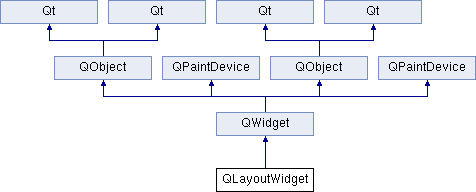|
Eneboo - Documentación para desarrolladores
|
|
Eneboo - Documentación para desarrolladores
|
#include <widgetfactory.h>

Métodos públicos | |
| QLayoutWidget (QWidget *parent, const char *name) | |
| QSizePolicy | sizePolicy () const |
| void | updateSizePolicy () |
Métodos protegidos | |
| void | paintEvent (QPaintEvent *) |
| bool | event (QEvent *) |
Atributos protegidos | |
| QSizePolicy | sp |
| QLayoutWidget::QLayoutWidget | ( | QWidget * | parent, |
| const char * | name | ||
| ) | [inline] |
This is the main event handler; it handles event e. You can reimplement this function in a subclass, but we recommend using one of the specialized event handlers instead.
The main event handler first passes an event through all event filters that have been installed. If none of the filters intercept the event, it calls one of the specialized event handlers.
Key press and release events are treated differently from other events. event() checks for Tab and Shift+Tab and tries to move the focus appropriately. If there is no widget to move the focus to (or the key press is not Tab or Shift+Tab), event() calls keyPressEvent().
This function returns TRUE if it is able to pass the event over to someone (i.e. someone wanted the event); otherwise returns FALSE.
Reimplementado de QWidget.
| void QLayoutWidget::paintEvent | ( | QPaintEvent * | ) | [protected, virtual] |
This event handler can be reimplemented in a subclass to receive paint events.
A paint event is a request to repaint all or part of the widget. It can happen as a result of repaint() or update(), or because the widget was obscured and has now been uncovered, or for many other reasons.
Many widgets can simply repaint their entire surface when asked to, but some slow widgets need to optimize by painting only the requested region: QPaintEvent::region(). This speed optimization does not change the result, as painting is clipped to that region during event processing. QListView and QCanvas do this, for example.
Qt also tries to speed up painting by merging multiple paint events into one. When update() is called several times or the window system sends several paint events, Qt merges these events into one event with a larger region (see QRegion::unite()). repaint() does not permit this optimization, so we suggest using update() when possible.
When the paint event occurs, the update region has normally been erased, so that you're painting on the widget's background. There are a couple of exceptions and QPaintEvent::erased() tells you whether the widget has been erased or not.
The background can be set using setBackgroundMode(), setPaletteBackgroundColor() or setBackgroundPixmap(). The documentation for setBackgroundMode() elaborates on the background; we recommend reading it.
Reimplementado de QWidget.
| QSizePolicy QLayoutWidget::sizePolicy | ( | ) | const [virtual] |
Reimplementado de QWidget.
| void QLayoutWidget::updateSizePolicy | ( | ) |
QSizePolicy QLayoutWidget::sp [protected] |
 1.7.4
1.7.4